Utilizing Reed Relays for Medical Equipment
Many types of medical equipment can benefit from the use of reed relays. Most standard relays can be used to switch signals and low voltages in non-safety-critical analysis and monitoring equipment, and high-voltage reed relays are suitable for switching high voltages (of up to 12.5kV, for Pickering devices) in high-energy scanners.
High-voltage reed relays are also used in defibrillators. For example, in a basic monophasic defibrillator (figure 1 shows a simplified diagram), the job of the reed relay is to complete a circuit that charges a capacitor. When the capacitor is fully charged, the reed relay effectively removes it from the charge circuit for inclusion in the discharge circuit – which is made complete by the placement of the paddles on the patient’s chest and the depression of paddles’ switches. Biphasic defibrillators are a little more complex, but the principle of operation (and the reed relay’s role) remains the same.

![Medical-Guide—Defibrulator-v2[78] Medical-Guide---Defibrulator-v2[78]](https://www.pickeringrelay.com/wp-content/uploads/elementor/thumbs/Medical-Guide-Defibrulator-v278-qb8o8jwby1e5pdw2o6qq6z4le7xrwhtsc8vgbymc0e.png)
Figure 1 – Above, a basic circuit diagram of a monophasic defibrillator.
High-voltage reed relays can also be used to establish a safe and reliable connection between low- and high-voltage circuits in, for instance, x-ray machines that have a low-voltage circuit for control purposes (and exposure timing) and a high-voltage circuit to accelerate electrons within the tube. Similarly, computerized tomography (CT – which uses x-rays) and magnetic resonance imaging (MRI) scanners incorporate both low- and high-voltage circuits, with the latter sometimes exceeding 100kV.
Furthermore, high-voltage reed relays can be used in electrosurgical generators for electronic scalpels, which require the switching of high voltages at high frequencies, circa 1MHz, to perform cutting and cauterizing simultaneously.
Within many of the above examples, not only is the ability to switch potentially high-voltages important, but so is high-isolation resistance (between the low- and high-voltage circuits).
However, not all reed relays used in medical equipment necessitate high-voltage capabilities. They may though require other properties not found in standard devices. For example, reed relays that have been designed specifically for data acquisition and instrumentation applications are ideal for use in medical monitoring and controlled treatment applications.
Additionally, reed relays with higher than usual coil resistance are suitable for battery powered / portable medical equipment – as the current draw will be lower than if a standard device were to be used.
In all the above-mentioned applications, ensuring high reliability is essential. The reed relay must operate when required and, if switching a high voltage, it must be fail-safe in case there is a fault in the (lower voltage) control circuitry, for example. In addition, reed relays are used extensively in automatic test equipment (ATE) employed for quality assurance during the manufacture of medical equipment.
To read more download our new application guide about utilizing reed relays for medical equipment. Discover how defibrillators, electrosurgical generators and a variety of medical analysis/monitoring equipment can all benefit from high-reliability reed relays.
Contents of this application guide:
- Medical Applications
- Switching Technologies
- Reed Relay Terminology
- Recommended Products
- Why Pickering Electronics for Reed Relays?

Recommended Reed Relays for use in Medical Equipment
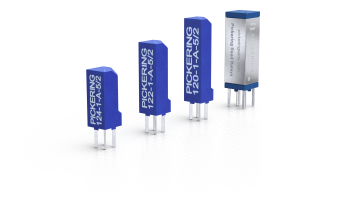
Ultra High Density Reed Relays
These relays have a maximum switch current of 1A (up to 20W), and the maximum carry current is 1.2A. Fast operate and release times (as low as 80μs or less) make these relays suitable for high-speed test systems. Body dimensions from (W x H x D): 3.9 x 9.5 x 3.9mm. Available forms: 1 Form A & 2 Form A contact configurations.
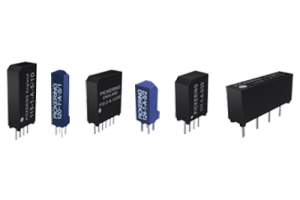
High Density Reed Relays
These relays have a maximum switch current of 1A (up to 20W), and the maximum carry current is 1.2A. Switches feature sputtered ruthenium contacts for long life and high reliability. Body dimensions from (W x H x D): 6.6 x 9.5 x 3.7mm. Available forms: 1 Form A, 1 Form A Coax, 2 Form A, 1 Form B, and 1 Form C contact configurations.
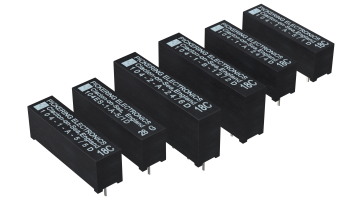
Miniature High-Voltage Reed Relays
These relays have switching voltages up to 1.5kV and standoff voltages up to 5kV. The maximum switch current is 1A (up to 25W) and the maximum carry current is 1.5A. High coil resistance options (up to 6.8kΩ). Thermal EMF devices are between 3 and 10μV. Relays can endure temperatures as high as 150°C if requested. Body dimensions from (W x H x D): 12.5 x 6.6 x 3.7mm. Available forms: 1 Form A, 2 Form A, and 1 Form B contact configurations.
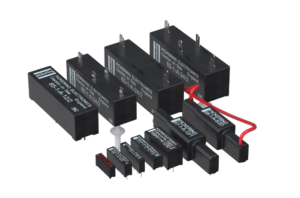
High Voltage Reed Relays
These relays have switching voltages up to 12.5kV and minimum standoff voltages up to 20kV. The maximum switch current is 3A (up to 200W) and the maximum carry current is up to 5A. Option of PCB pins, chassis, PCB mounting, and flying leads. Body dimensions from (W x H x D): 58.4 x 19.0 x 12.6mm. Available forms: 1 Form A, 1 Form B, and 1 Form C contact configurations.
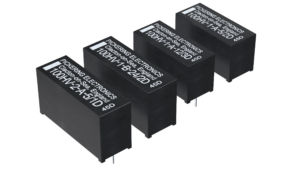
High Coil Resistance Reed Relays
These relays have a maximum switch current of 1A (up to 20W), and the maximum carry current is 1.2A. Featuring high coil resistances (up to 6kΩ), devices are ideal for portable instruments. Body dimensions from (W x H x D): 8.13 x 15.24 x 4.8mm. Available forms: 1 Form A, 2 Form A, 1 Form B, and 1 Form C contact configurations.
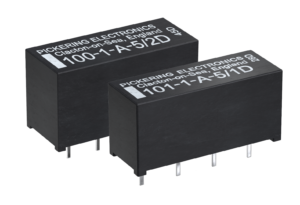
Low Thermal EMF Reed Relays
These relays have a maximum switch current of 1A (up to 20W), and the maximum carry current is 1.2A. Devices feature low thermal EMF (around 1μV or less) and low power consumption. Body dimensions from (W x H x D): 20.1 x 9.4 x 7.4mm. Available forms: 1 Form A, 2 Form A, 1 Form B, and 1 Form C contact configurations.
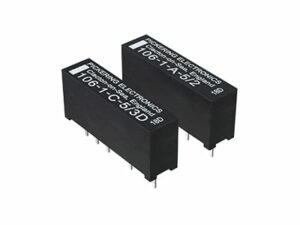
Industry Standard Size Reed Relays
These relays have a maximum switch current of 1A (up to 20W), and the maximum carry current is 1.2A. Featuring superb contact resistance stability and ultra-high insulation resistance. Body dimensions from (W x H x D): 19.1 x 7.6 x 4.8mm. Available forms: 1 Form A, 2 Form A, 1 Form B, 1 Form C, and 2 Form C contact configurations.
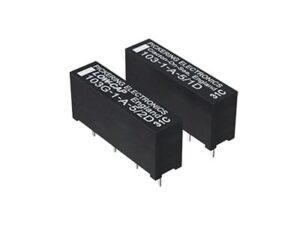
Low Capacitance Reed Relays
These relays have a maximum switch current of 1A (up to 20W), and the maximum carry current is 1.2A. Ultra-low capacitance levels of typically 0.1pf, compared to typically 2.5pF for a standard device. Body dimensions from (W x H x D): 19.1 x 8.1 x 4.8mm. Available forms: 1 Form A contact configuration.
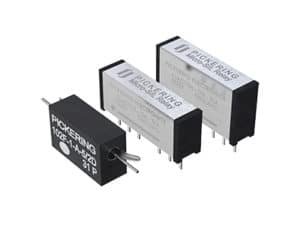
Coaxial Reed Relays
These relays have a maximum switch current of 1A (up to 20W), and the maximum carry current is 1.2A. Devices with 50 and 75Ω coils are suitable for up to 5GHz, making them ideal for RF Signal Switching, RF switched tunable filters, and High-Speed Digital Switching. Available in thru-hole and SMT. Body dimensions from (W x H x D): 12.5 x 6.6 x 3.7mm. Available forms: 1 Form A and 1 Form B






